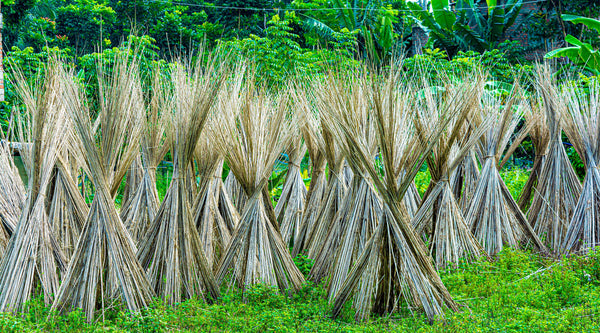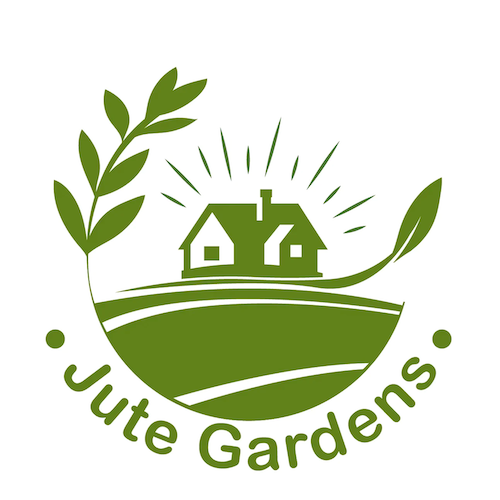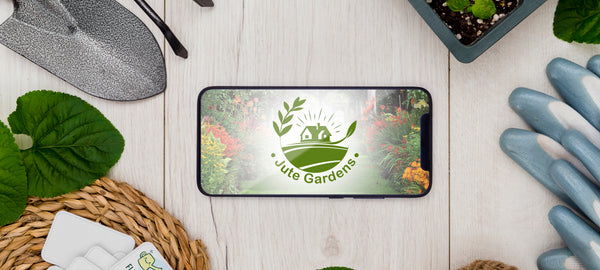
What is Jute?
Jute is versatile. Jute is biodegradable. Jute is made from a renewable resource.
If you've picked up a home decorating magazine and flipped through its pages anytime in the last fifty years, chances are you've seen some sort of Jute adornment prominently featured in the bright, glossy pictures. Whether as a rug lain over the floor or baskets holding beautiful trinkets, Jute is a favorite material among interior designers. As beautiful as it is to look at, this durable fiber has been a mainstay among people for generations, providing a means to transport food and survive when conditions were rough. But what is this versatile textile, and why does it have the ability to help save the planet? Let's take a closer look and find out!
What Is Jute?
Jute is a plant grown in tropical regions like Bangladesh and India, which is harvested for its long and shiny fibers that are spun into coarse threads. Jute is one of the easiest textiles to produce, biodegradable, and incredibly sturdy, making it the ideal material for rope, shopping bags, and rugs. Thanks to its immense strength, Jute can hold many times its weight, making it perfect for carrying grains and produce. Its durability makes it a popular option for high-traffic products like laundry baskets, cushions, plant vases, and even curtains.
Jute is considered one of the most versatile fabrics, second only to cotton, and one of the most commonly frown fibers used globally. Since it takes very little water to grow, much less than cotton, and little to no pesticides or fertilizers, it's considered one of the top eco-friendly crops available. The Jute fibers are made from the bark of the white Jute plant, but due to its golden tint, it's commonly called the "Golden Fiber." When the light hits these fibers just right, there is a stunning sheen that is one of the biggest selling points of this beautiful material.
The Jute plant requires a highly humid environment to grow, which is why the bulk of the world's Jute farms are in tropical regions like Nepal, India, Myanmar, and Bangladesh. In fact, 85% of all the world's Jute is grown in Bangladesh! Jute farmers are very considerate of their farming tactics, rotating their crops every year to ensure the health of the plants and the earth around them. This practice stops vitamin and mineral depletion from the ground, helping sustain a healthy environment while creating a strong and robust crop.
Jute is highly insular, making it a popular choice for rugs that cover the floor, keeping it warm in winter and cool in summer. It also provides cushion and protection while providing a beautiful centerpiece for the space.
Jute Harvesting
Jute seeds are planted and allowed to grow until the plants reach around fifteen to twenty centimeters tall. Once they reach this height, the farmers thin out the crop, ensuring the remaining plants continue to grow healthy and strong until harvesting. After flowering, harvest occurs, with the stalks cut a few inches from the ground, tied in bundles, and allowed to soak in water for around twenty days.
This is a crucial process as it softens the fiber tissues and begins breaking down the pectin, which bonds the outer plant to the fibrous tissues within. After their soak, the stalks are stripped of their hard outer shell, and the internal fibers are separated into long, flowing strands, which are washed under running water. Once clean, they are hung and allowed to dry, at which time they will once again be tied into bundles for transport.
The separation of the hard external shell from the inner fibers is called retting, and farmers use multiple processes to accomplish this task. They include chemical retting (boiling and adding a chemical substance), mechanical retting(hammering), vapor/steam retting, and microbial or water retting. Microbial or water retting has been the norm for thousands of years, but the chosen process depends on water availability and cost.
It is interesting to note that although with water retting, the stalks generally stay submerged for twenty days, it may take less time if the crop itself is of a higher quality.
Why Is Jute Considered A Renewable Resource?
Jute is one of the world's most popular renewable resources, but what is it about this plant that makes it so eco-friendly? To start, it is 100% biodegradable, completely breaking down without leaving excess waste. It is also fully recyclable as the fibers can withstand the re-manufacturing process without losing their integrity.
Jute grows incredibly fast, especially compared to other crops, reaching full maturity in only four to six months. This expedited growing makes it highly efficient and sustainable, similar to Bamboo. Like Bamboo, Jute absorbs carbon dioxide from the air and releases oxygen much faster than trees. Jute alone can consume around fifteen tons of carbon dioxide and release eleven tons of oxygen! Jute doesn't require the use of harmful and devastating irrigation systems; instead solely relying on natural rainfall for its water source, which doesn't deplete the environment or cause mass deforestation.
Popular Jute Uses
Jute has built-in UV protection, not requiring the use of pesticides or fertilizers, which can harm the soil, seep into the water cycle, and poison vegetational, animals, and people in surrounding areas. In fact, Jute enhances the soil it grows in, making it more fertile than before, aiding future crops, and producing healthier plants.
Although most people only think of Jute as a fiber used for creating durable and beautiful textiles, every part of the plant is usable, making it a net-zero crop! Jute leaves are a popular delicacy, boiled in water and eaten as highly nutritious vegetables. The outer hurd is often used for fuel or as a common building material, thanks to its strength and flexibility. Jute fabric has multiple uses, too, thanks to its breathability and affordability.
While in the western world, Jute fabric is not commonly used in apparel, South Asian and Indian countries often use the material for their clothing. In the past, the Indian culture regarded Jute as a lower-class material thanks to its affordability, but it has seen a resurgence in popularity, being used in luxury brands like Prada.
Of course, Jute is a popular material in bags since it can hold many times its weight without fraying or breaking. Burlap bags, which are used throughout the world for transporting goods like grains, fruits, and vegetables, are often made with Hessian cloth, which is a form of Jute. It is also used agriculturally to help control erosion, manage weeds, and protect newly planted seeds. Seedlings are often wrapped in Jute for protection during transplantation since the biodegradable fibers will break down after being planted, removing the need to unwrap the root prior to implantation.
The fibers are easily dyed in almost any color, allowing them to perfectly match all decors or simply kept the nature tan or golden shade for a. more natural look. Jute is also a popular choice for furniture thanks to its stylish look and low price. DIYers love Jute for its versatility, often wrapping Jute cord into fun and exciting shapes to produce placements, coasters, or vases.
If you're looking for a sustainable and beautiful way to grow your favorite plants, turn to Jute Gardens. Jute Gardens offers beautiful Jute fiber grow pots that you can use throughout the entire life cycle of your plant, from seed to transplantation or as a stand-alone planter. Thanks to the 100% compostable and biodegradable nature of every Jute grow pot, you can simply insert your plant into the soil as the seasons end, making it the easiest way to help ensure the health of your precious plants.
You can choose from a five-gallon grow pot that's perfect for a wide arrange of your favorite plants or a five-pack of one-gallon grow pots to start your garden on the right track.
At Jute Gardens, we're dedicated to helping you grow your best life sustainably, offering a wide range of eco-friendly home and garden products that make sustainability fun. Whether you are looking to increase your nutrition with a microgreen growing kit, add color and warmth to your indoor or outdoor space with a living wall or vertical growing kit, or use eco-friendly growing pots, Jute Gardens has you covered.
Whatever your goals, our passion is to help you live sustainably by using a sustainable business model that balances our economic, social, and environmental responsibilities. We only have this one planet, and it's our job to care for it; So what are you waiting for? Discover how much fun sustainable living can be with Jute Gardens!

